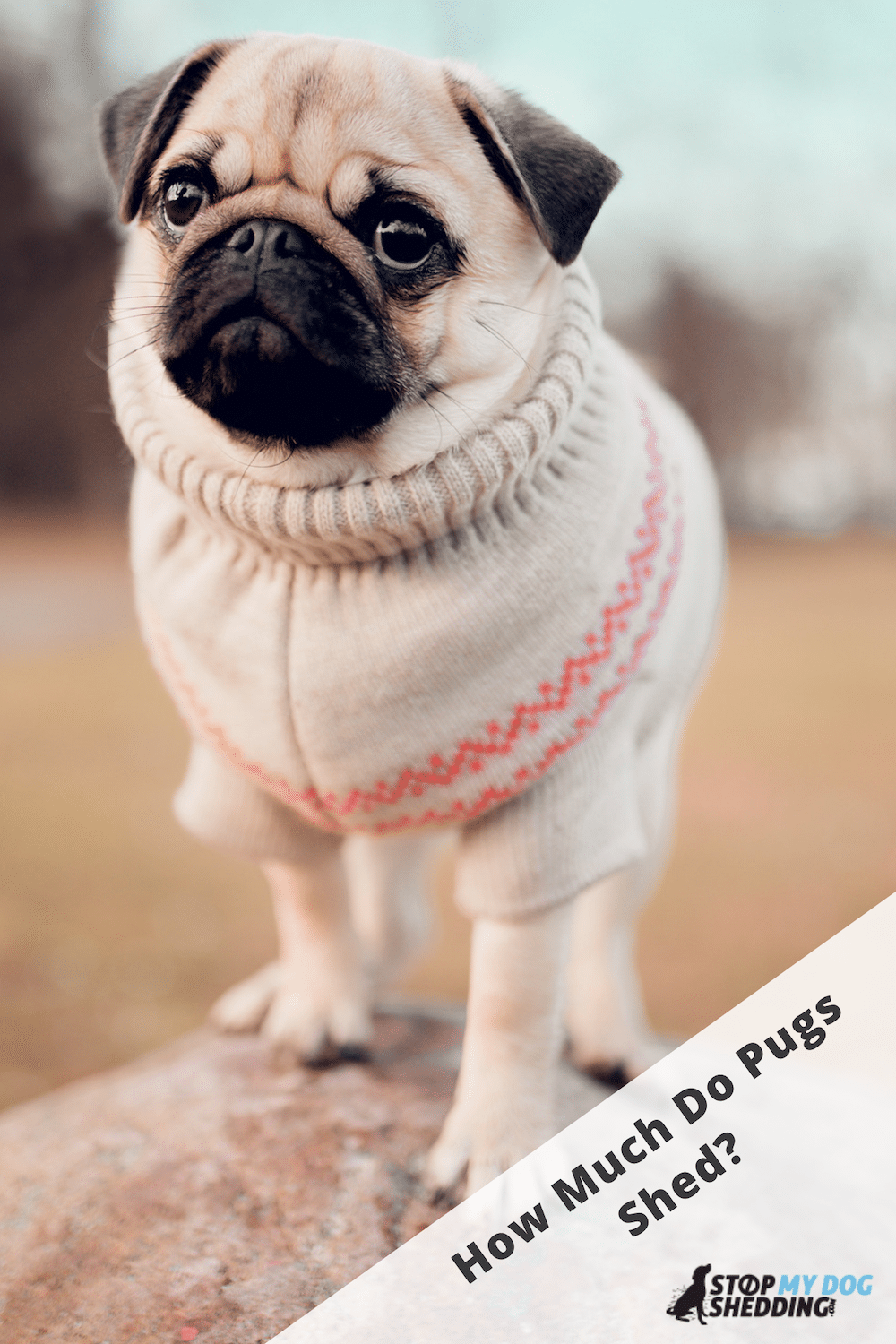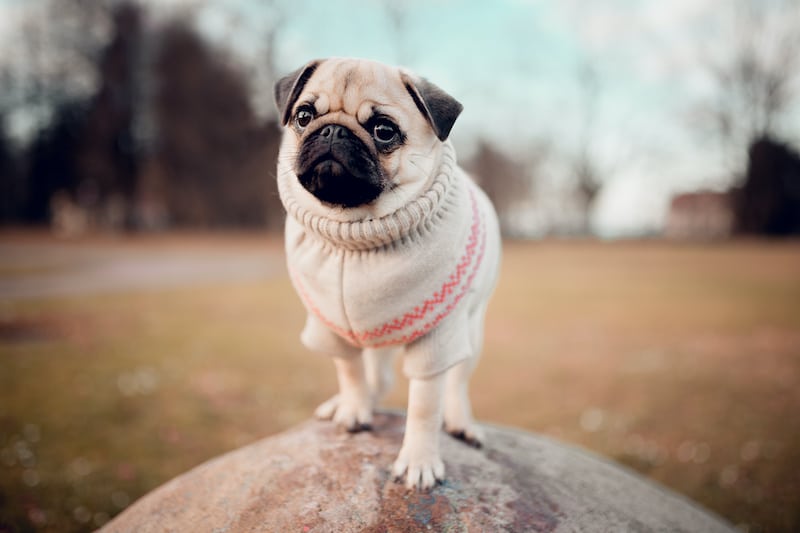Pugs were once the prized companions of Chinese emperors and Dutch royalty. That is, until their adorable, gentle nature saw them win the hearts of people from all over the globe.
Do they shed much? Pugs are small dogs with short, easy to maintain coats, but don’t let that fool you, they’re actually a heavy shedding breed. The reason they shed so much is because they have a short coat with a short hair growth cycle, and an undercoat that is continuously growing and pushing out the top coat.
Let’s take a closer look at how much hair they shed, what they’re like to groom and what makes these cute little fur babies so great.
Recommended: Go here to see our top-rated dog hair blow dryers
How Much Do Pugs Shed?
Pugs are a heavy shedding breed. In fact, they are up there with the heaviest shedders on the planet, it’s remarkable how much hair a small dog can actually lose.
Their coat is made up of both a top coat, which is short and smooth, and an undercoat, which is soft and thick. Normally dogs with a double coat shed seasonally during spring and fall, but that’s not the case with Pugs. They shed about the same amount, year round.
One of the reasons for this is simply because they have such short coats. Which many people mistakenly think means the dog won’t shed much, but this couldn’t be further from the truth.
Shorter coats actually decrease the life cycle of the hair, or more accurately, fur. The fur falls out once it’s fully grown to make way for new fur, so the shorter it is in length, the faster it falls out.
The other reason they shed more is because they have a thick, soft undercoat which is constantly growing and causes the top coat to fall out more than single coat breeds, like the French Bulldog for example.
The good news is that getting the shedding under control is quite simple when you follow a simple grooming regime, so let’s explore that now.
Recommended: Go here to see our top-rated dog hair blow dryers
What Are Pugs Like to Groom?
Pugs are very easy to groom. Keeping your Pug’s coat in good shape is a simple matter of brushing once or twice per week. You can brush more often than this to control shedding, but this is not required.
Either way, the best brush to use is a simple bristle brush or rubber hand mitt. Not only will this remove the dead hairs from the source, but it helps to keep their coat healthier because it spreads the coat oils evenly over the skin. Which helps prevent excessive hair loss due to dry, irritated skin.
You could also use a quality deshedding brush which will reach down further to the undercoat and remove more dead fur. Although this isn’t essential, it can save you some time in the long run.
Aside from brushing, you can also bath your Pug, but only if he really needs it. Over bathing can actually worsen shedding because it can dry out the skin. Just as using human shampoos, or low quality dog shampoos, can do. So it’s generally best to keep it to a simple brushing session most of the time.
Are Pugs Hypoallergenic?
No, Pugs are not hypoallergenic. In fact, they are far from it considering how much hair they shed year round.
No dog is every 100% hypoallergenic though, not even hairless breeds, because the allergens don’t just come from the hair itself, they come from a dogs dry saliva and dander (dead skin flakes).
So even dogs that don’t shed or that have literally no hair, can cause allergies to flare up. It’s just that dogs that shed more heavily are worse because the allergens attach themselves to the hair and float around the home when that hair falls out.
Examples of hypoallergenic breeds include the American Hairless Spaniel, Poodle, Mini Schnauzer, Wheaten Terrier and Basenji, but these are quite a few more.
How to Reduce Excessive Shedding
The best way to reduce shedding in your Pug is to brush regularly with a bristle brush. Once per week is all that is needed, but if you’re noticing an excessive amount of fur falling out, you can step this up to daily or every second day.
This is fine because brushing with a soft bristle brush is actually good for them. Not only does it remove the dead hair from the source, but it can help prevent further shedding by distributing the oils of the coat over the skin.
Almost all dogs shed to some extent, so there’s nothing you can do to stop it, nor should you try, because this is a completely natural occurrence. But, besides brushing, there are some ways you can minimize the amount of hair that falls out, and win the battle of the hairs!
Read: How to Stop Your Dog Shedding Excessively
One thing you can do is ensure your Pug is receiving a well balanced diet that contains the recommend nutrients, vitamins and minerals he needs. As well as Omega 3 fatty acids contained in stuff like tuna, salmon and flaxseed which can promote a moisture rich coat.
The reason this can help is because dry skin and dry hair is a leading cause of shedding, so getting their diet in order can help to bring this into balance, and reduce dryness.
You could also try a simple, and safe, home remedy like adding a teaspoon of virgin coconut oil to your Pug’s food. Or some people prefer virgin olive oil as a shedding remedy instead. You don’t want to go overboard here, but a very small amount each day, or even a couple times per week, can work wonders.
Recommended: Go here to see our top-rated dog hair blow dryers
To Pug or Not to Pug?
Pugs are a one-of-a-kind breed that can be characterized as charming, loveable and mischievous. They are described in Latin as being “much in little” or a “lot of dog in a small space.” Signifying that, while they may be small in size, they’re full of personality and courage.
They have an interesting heritage too.
The earliest record of Pugs dates back thousands of years to China, where emperors enjoyed their companionship. From there, in the 16th century, they found themselves in Holland’s royal House of Orange, before arriving in England to become a favorite of Queen Victoria in the 19th century. Eventually, in 1885, the Pug became an official recognized breed in the United States according to the American Kennel Club (AKC).
So they’ve had quite the royal journey! From Chinese emperors, to Dutch and English royalty. Now they’re one of the most popular breeds in the world, people from all walks of life love these gentle, social and charming companions.
Pugs are also known to be good around other dogs and children.
They are strong willed, but typically not aggressive, and just love human companionship. They’ll happily snooze and lounge around the home, following their humans everywhere and anywhere, which is why they’re often called “shadows.”
So, if you’re looking an easy to groom companion that will fit right in to just about any lifestyle, and one that is simply adorable, then the Pug is for you.
They do shed quite a bit, but nothing you can’t keep under control with a simple brushing routine and by following some of the other tips mentioned in this article.
FAQ
How Often Do Pugs Shed?
Pugs shed fairly evenly year round, which is typically not the case with a double coated breed like this, but they are in a league of their own, after all.
How Do You Stop Your Pug From Shedding?
You can’t stop your Pug from shedding, nor should you try to. Like all dogs, Pug shedding is a normal and healthy thing, so the best thing you can do is manage it. Which mostly comes down to brushing.
Do Pugs Have Hair or Fur?
The term “hair” and “fur” are synonymous when it comes to describing a dogs coat, but there is a difference, and Pugs have fur. The main difference is that hair doesn’t stop growing, while fur does and thus falls out at a faster rate. Dogs with hair include breeds like the Afghan Hound and Poodle for example.
Alternative Breeds to Consider
Some good alternative breeds, that don’t shed quite as much, include the French Bulldog, Chihuahua, Shih Tzu and Boston Terrier. Some of these breeds do take more effort to groom though, and there are other low shedding breeds that are worth considering.













Please note: By submitting a comment using the above comment form, you confirm that you agree with the storage and handling of your data by this site as detailed in our Privacy Policy.